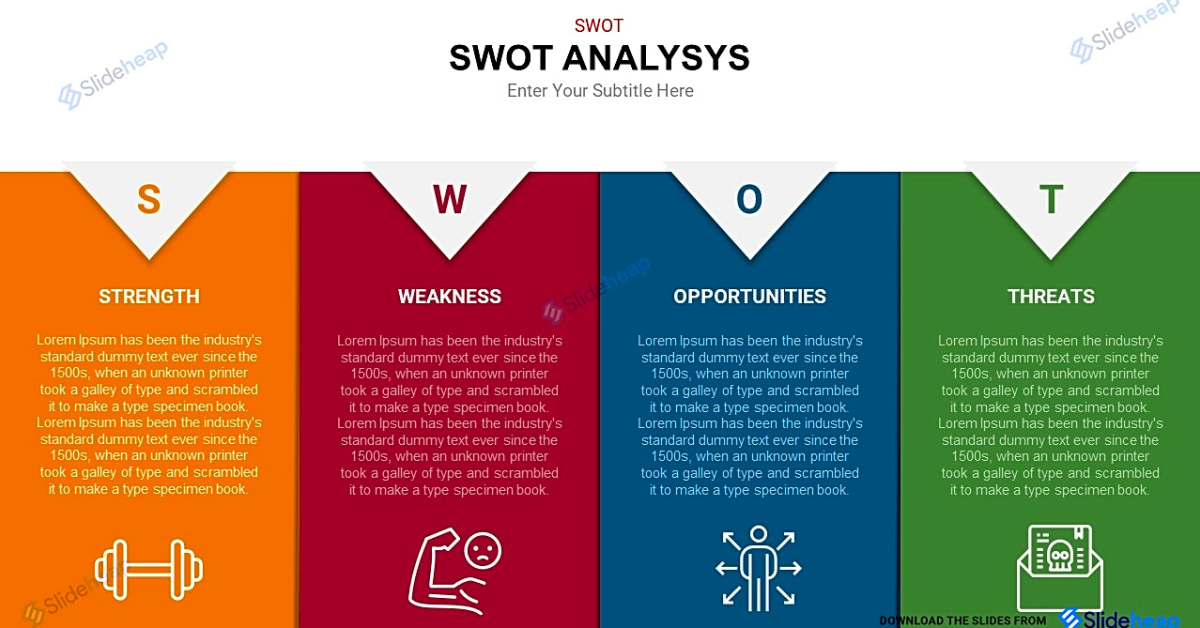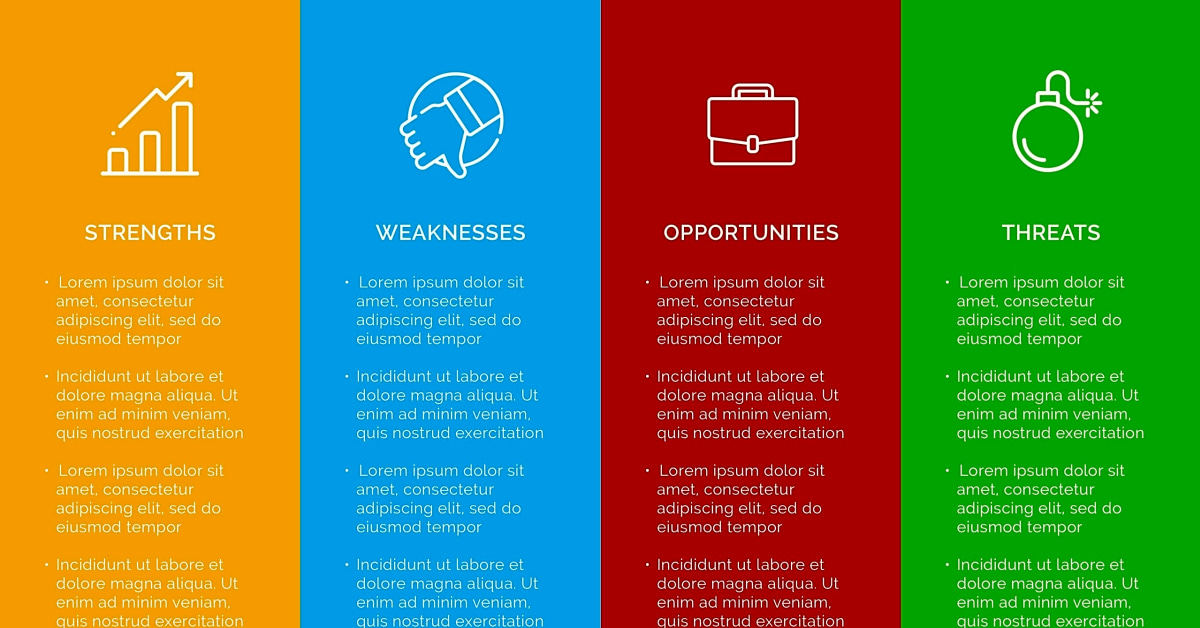Welcome to our comprehensive guide to Simple SWOT Analysis templates! Whether you are a business owner, a student, or simply looking to improve your decision-making skills, understanding the basics of SWOT analysis is essential. In today’s fast-paced world, it’s crucial to have a strategic planning tool that can help you evaluate the strengths, weaknesses, opportunities, and threats of your organization or project. And that’s where SWOT analysis comes in. It is a simple yet powerful technique that can provide valuable insights and help you make informed decisions. In this article, we will take an in-depth look at Simple SWOT Analysis templates and how they can be used to improve your overall strategy. So, grab a cup of coffee and get ready to learn all about SWOT analysis templates and how they can benefit you!
In today’s fast-paced and competitive world, it is important for individuals and businesses to have a clear understanding of their strengths, weaknesses, opportunities, and threats. This is where SWOT analysis comes in, as it is a simple yet effective framework that can help you analyze and strategize for success. Whether you are a beginner looking to understand what SWOT analysis is, or a professional seeking templates and tools to enhance your analysis, this article has got you covered.
SWOT analysis stands for strengths, weaknesses, opportunities, and threats. It is a strategic planning technique used to evaluate the internal and external factors that can impact the success of an individual or organization. This powerful tool allows you to identify key areas for improvement and make informed decisions based on your findings.
The benefits of conducting a SWOT analysis are numerous. It can help you understand your competitive advantage, identify potential risks, and uncover new opportunities for growth. By analyzing both internal and external factors, you can gain a holistic view of your current situation and make more informed decisions.
When it comes to SWOT analysis, there are four main components that need to be considered: strengths, weaknesses, opportunities, and threats. Strengths and weaknesses refer to internal factors such as skills, resources, and processes. Opportunities and threats refer to external factors such as market trends, competition, and economic conditions.
Identifying these components requires careful analysis and assessment. A good way to do this is by asking yourself questions such as: What are our strengths? What are our weaknesses? What opportunities exist in our industry? What potential threats could impact our success?
To give you a better understanding of how SWOT analysis can be applied in different contexts, here are some examples:
- Business SWOT Analysis: A business can use SWOT analysis to evaluate its current position in the market and identify areas for improvement. This can include analyzing their products or services, customer base, competition, and market trends.
- Personal Development SWOT Analysis: Individuals can use SWOT analysis to assess their own strengths and weaknesses, as well as potential opportunities and threats in their personal and professional lives. This can help them make decisions to improve their skills and achieve their goals.
- Competitive SWOT Analysis: Companies can use SWOT analysis to compare themselves with their competitors and identify areas where they have a competitive advantage or are at a disadvantage. This can help them develop strategies to stay ahead in the market.
Now that you have a better understanding of how SWOT analysis works and its various applications, let’s discuss the different templates and tools available for conducting a SWOT analysis. Traditional 2×2 matrix templates are commonly used for visualizing the four components of SWOT analysis. Digital templates, such as those available on Microsoft Word or Google Docs, offer a more convenient and customizable option. There are also software options, such as SWOT analysis software or online tools, that can help you conduct a more in-depth analysis with the use of data and charts.
To make your SWOT analysis even more effective and efficient, here are some tips to keep in mind:
- Be honest and objective when evaluating your strengths, weaknesses, opportunities, and threats.
- Involve key stakeholders in the process to gain different perspectives.
- Use real-life examples and data to support your findings.
- Regularly review and update your SWOT analysis to stay relevant in a constantly changing market.
With the help of this comprehensive guide, you now have all the necessary information to conduct a simple SWOT analysis and use it to your advantage. Whether you are a student, professional, or business owner, SWOT analysis can be a valuable tool in achieving success. So don’t wait any longer, start analyzing and strategizing for a better future today!
Identifying Strengths, Weaknesses, Opportunities, and Threats
When conducting a SWOT analysis, it is important to have a clear understanding of each component and its role in the overall analysis. Here are some tips to help you identify and analyze each component effectively:
Strengths: These are internal factors that give you an advantage over your competitors. They can include your unique skills, resources, and assets that set you apart from others in the market.
Weaknesses: These are internal factors that may hinder your success. They can include areas where you lack skills or resources, as well as any limitations or challenges you may face.
Opportunities: These are external factors that you can capitalize on to further your success. They can include market trends, advancements in technology, or changes in consumer behavior.
Threats: These are external factors that may pose a risk to your success. They can include competition, economic changes, or any other external factors that may impact your business.
By clearly identifying each component and understanding their role in the analysis, you can gain a better understanding of your current situation and make informed decisions for the future.
Templates and Tools for Conducting a SWOT Analysis
When conducting a SWOT analysis, having the right template and tools can greatly enhance the process. Here are some of the top options available:
- Basic SWOT Analysis Template: This is a simple and straightforward template that allows you to list out the four categories of SWOT analysis in a clear and concise manner.
- Advanced SWOT Analysis Template: For those looking for a more detailed analysis, this template provides additional sections for further analysis, such as external factors, key success factors, and potential strategies.
- Online SWOT Analysis Tools: There are various online tools available that can guide you through the process of conducting a SWOT analysis step-by-step. These tools often provide templates, tips, and examples to help you create a comprehensive analysis.
- SWOT Analysis Software: For businesses or individuals who conduct SWOT analyses frequently, investing in software can be beneficial. These programs offer customizable templates, data analysis tools, and other features to streamline the process.
No matter which option you choose, it is important to consider your specific needs and goals when selecting a SWOT analysis template or tool. With the right resources, conducting a thorough and effective SWOT analysis can be made much easier.
Examples of SWOT Analyses
SWOT analysis can be applied to a variety of situations and industries, and here are a few examples to help you understand its practical application:
1. Personal SWOT Analysis: If you are an individual looking to assess your strengths and weaknesses to improve your career or personal life, a personal SWOT analysis can be a useful tool. You can identify your strengths and leverage them for opportunities, while also working on your weaknesses to minimize threats.
2. Business SWOT Analysis: For businesses, conducting a SWOT analysis can provide valuable insights into their current position and potential areas for growth. By analyzing the internal factors (strengths and weaknesses) and external factors (opportunities and threats), businesses can develop strategies to stay competitive in the market.
3. Product/Service SWOT Analysis: Before launching a new product or service, it is important to conduct a SWOT analysis to understand its potential success in the market. This will help identify any weaknesses or threats that need to be addressed before launching, as well as capitalize on strengths and opportunities to drive success.
4. Industry SWOT Analysis: Analyzing the strengths, weaknesses, opportunities, and threats of an industry as a whole can provide valuable insights for businesses operating within that industry. This can help businesses stay ahead of market trends and anticipate potential challenges.
Understanding SWOT Analysis
In today’s fast-paced and competitive world, it is important for individuals and businesses to have a clear understanding of their strengths, weaknesses, opportunities, and threats. This is where SWOT analysis comes in, as it is a simple yet effective framework that can help you analyze and strategize for success.
SWOT analysis stands for strengths, weaknesses, opportunities, and threats. It is a strategic planning tool that helps individuals and businesses identify internal and external factors that can affect their goals and objectives. By understanding these factors, you can make informed decisions and develop effective strategies to achieve success.
The benefits of using SWOT analysis are numerous. Firstly, it provides a comprehensive overview of your current situation. By identifying your strengths and weaknesses, you can leverage your strengths and address your weaknesses to improve your overall performance.
Secondly, SWOT analysis helps you identify potential opportunities that you may have overlooked. These opportunities can be used to your advantage and help you achieve your goals.
Lastly, by identifying potential threats, you can proactively prepare for them and minimize their impact on your goals and objectives. This can help you stay ahead of your competitors and maintain your success in the long run.
In conclusion, SWOT analysis is a valuable tool for individuals and businesses alike to evaluate their current state and plan for future success. With the availability of various templates and tools, conducting a SWOT analysis has become easier and more accessible. By following the guidelines and utilizing the examples provided in this article, you can create an effective SWOT analysis that can aid in decision-making and improve your overall performance.

